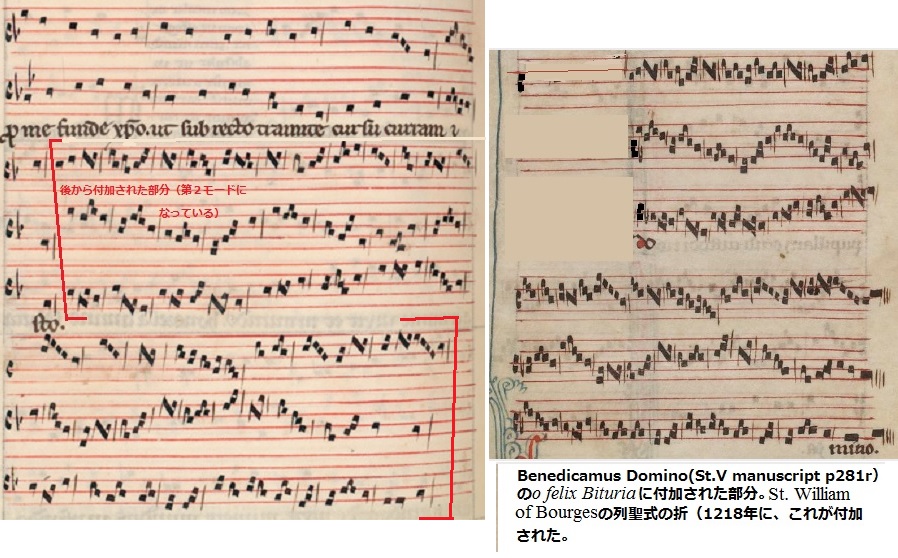| 第2モードの発展について |
音楽エッセイのページへ戻る
初期多声音楽
St.マーシャル楽派へ
中世音楽のページへ
Datable Conductusのページ1へ
レオナン Videruntへ
Datable"Notrdame Conductus1"へ
| 6つあるうちのリズモモードの中で、第二モードはより後から発展した。この過程を、Conductus o felix Bituriaで見てみよう。 このConductusは、1209年のSt. William Bourgesの死に際して作られた。ところが、最後のcadence部分のみは、1218年のWilliamの列聖に際に、それよりやや以前に作られていたBenedicamus Dominoのメリスマ部分が付加されて歌われた。 この”付加”に意義があるのは、これが第二モードで作られているからである。つまり、1209年以降、第二モードの斬新さが注目され、あえてこれが付加されたと考えることができる。一般的にConductusは13世紀以降、大きな発展をしたといえる。  magnus liber 第2巻 p63 http://gallica.bnf.fr/ark:/12148/btv1b8432457p/f225.item.zoomp281r ●Datable "Notre Dame" Conductus: New Historical Observations on Style and Technique5p35〜より Ernest Sanders notes an additional trait in the later works from the thirteen thcentury, discernible for the first time around 1210, in the exploration of the new iambic rhythmic patterns(第2モード)that complete the system of six rhythmic modes (Sanders 1985b: 510-12; Roesner 1990: 41-62). Although he correctly states that the earliest datable cauda with such rhythms appears in the final melisma of 0 felix Bituria from 1209, this final melisma presents some complexities in transmission since it also happens to appear independent of the conductus as a freely composed Benedicamus Domino setting from the Saint Victor codex (StV). The presence of this cauda in the guise of an organum raises the question as to when this portion of the piece was composed and whether or not it originally served aspart of the conductus, which otherwise is completely trochaic in its rhythms. A possible impetus for appending this melisma to the conductus at a time after its initial composition might be traced to the canonization of St. William of Bourges and the institution at Notre Dame of a liturgical feast in his honor. According to liturgical documents, William was sanctified in 1218, nine years after his death, but his feast was not added to the Parisian liturgy until more than a decade after he achieved sainthood. The later addition of a cauda in the new iambic rhythmic modes, based on an earlier freely composed Benedicamus Domino, would have served to embellish the older conductus further, and would even tie it to the liturgy for possible performance on William's feast day. But though the earliest appearance of the iambic rhythms of the second and third modes is difficult to determine for certain, they were certainly in use by the 1220s. Such evidence may not only help to fix the dates of the incursion of the various rhythmic modes into the conductus repertory, but also may illuminate the development of rhythmic style in the discant clausulae and the early medieval motet. Ernest Sandersは、13世紀になってから後、1210年頃に初めてはっきり見分けがつくようになった作品の付加的形質に着目し、6つのリズムモードシステムの仕上げとなる新しいiambic rhythmic pattern(第2モード)を調べた。 彼はこのような新しいリズムを持つもっとも早期のdatableなcaudaが、0 felix Bituria from 1209の最後のメリスマ部分にあることを正しく主張したが、この最後のメリスマ部分は、transmission におけるいくらかの複雑性を表している。なぜなら、St.V写本中のBenedicamus Domino の設定として、conductusの独立があきらかだからである。 オルガヌムのようにふるまうこのcaudaの存在は、この作品のこの部分がいつ作曲され、conductusの一部分としてオリジナルに作られたのかどうかという疑問を湧き上がらせる。さもないと、conductusのそのリズムは完全にtrochaicになっていたはずだからである。 このメリスマが、その作曲後しばらくしてconductusに付け加えられた可能性のある誘因は、St. William of Bourgesの戴冠式や彼の名誉のための儀式的祭祀を執り行ったノートルダム寺院の設立に求めることができよう。儀式典書によれば、Williamは1218年に聖別されたが、それは彼の死後、9年が経過してのことであった。しかし彼の祭祀は、彼が聖職に叙せられたあと10年以上も執り行われなかった。 新しいiambicなリズムモード(第2モード)で作られたcaudaの後の付加は、以前の自由に作曲されたBenedicamus Dominoを基盤にしていたが、古いconductusを装飾することとなり、そしてWilliamの祝日の可能な限りのパフォーマンスのための儀式と結びつけることとなった。 しかし、第2,3モードであるiambicリズムの最初期の出現は確認が困難であるが、table 11 が示すように、確かに1220年代までには使われている。こうした証拠は、conductusレパートリーに対するさまざまなリズムモードの出現期を決めるのに役立つだけでなく、ディスカントクラウズラや初期中世のモテットにおけるリズム形式の発展をも映し出すのである。 |